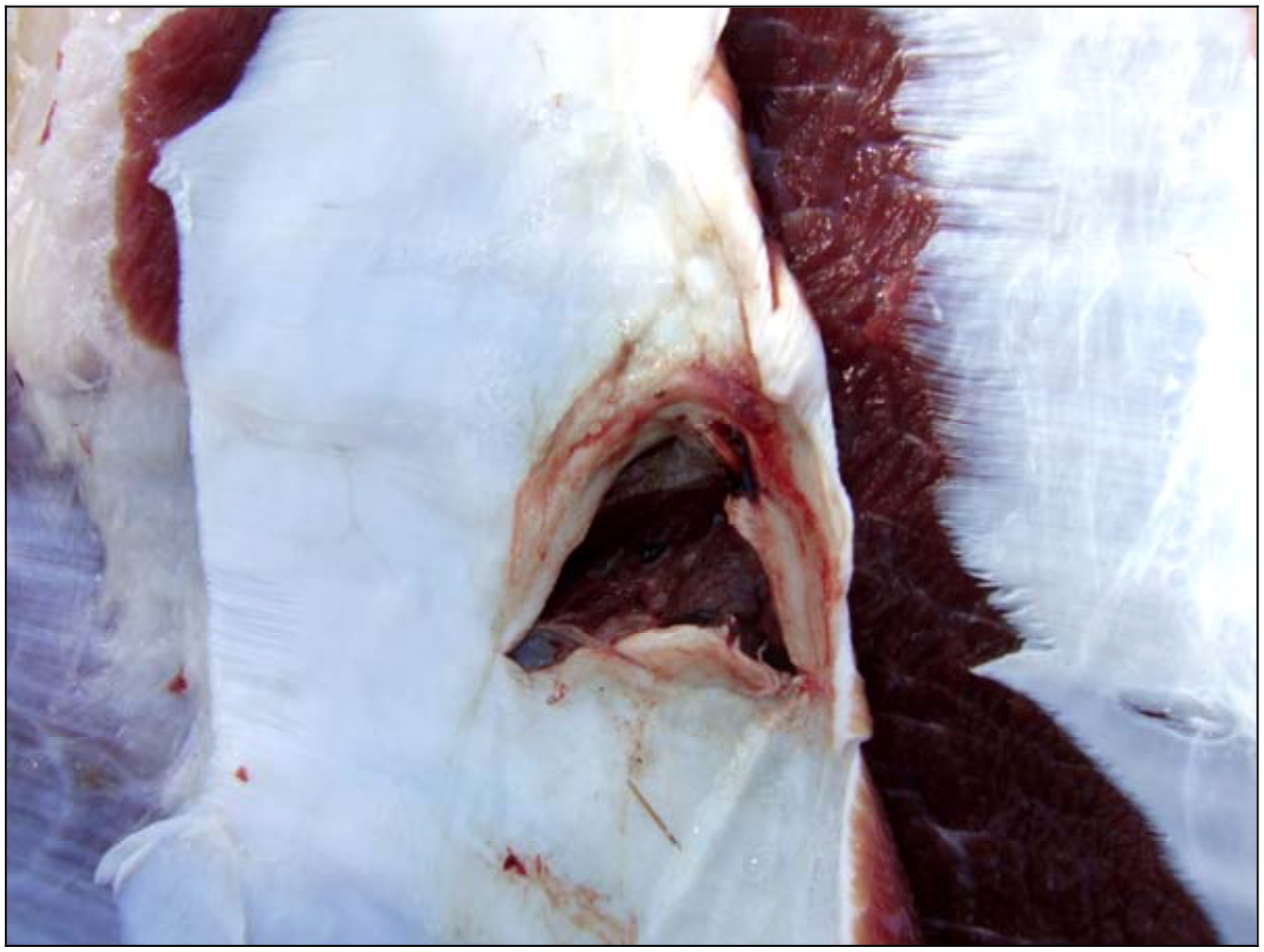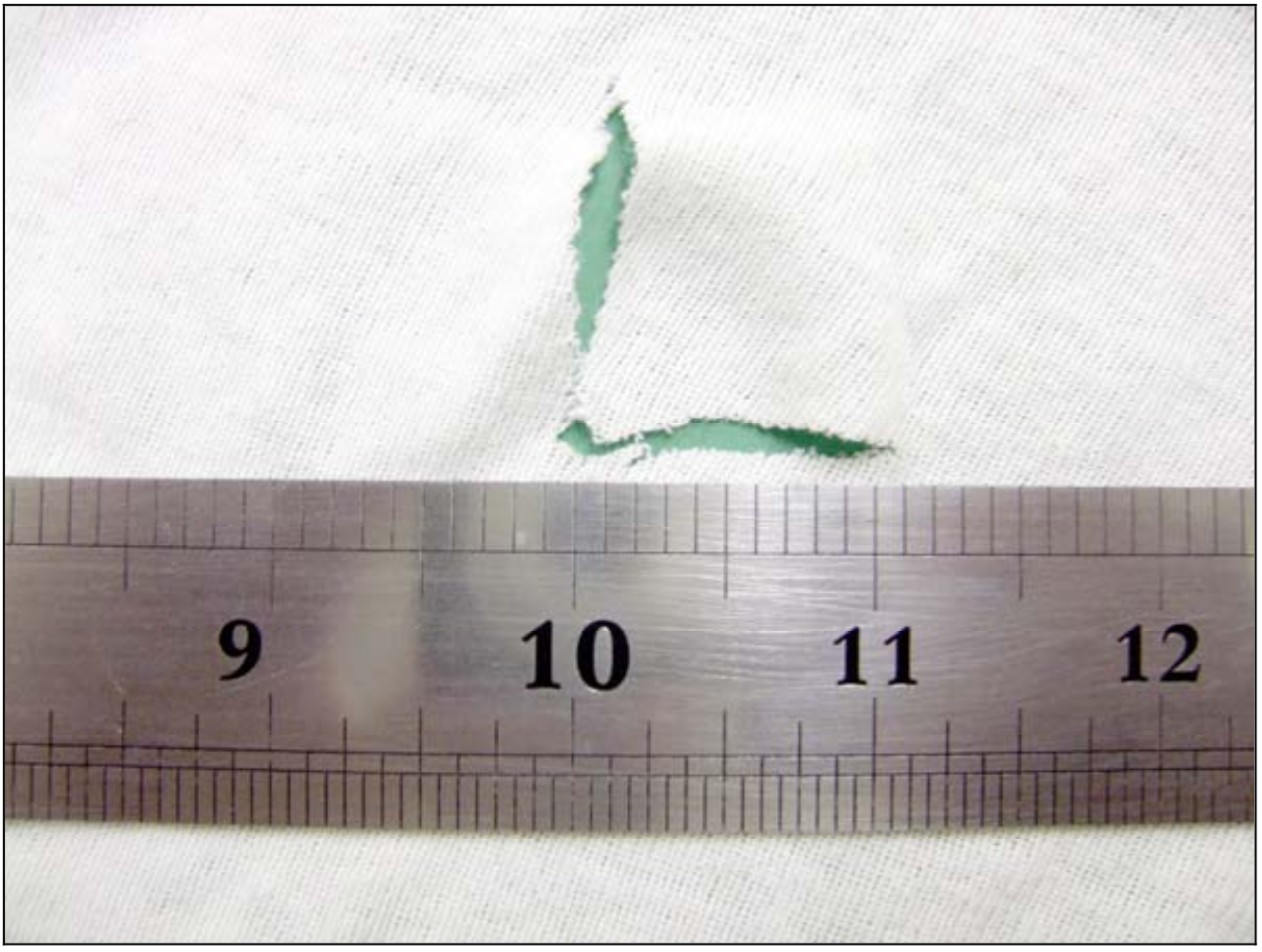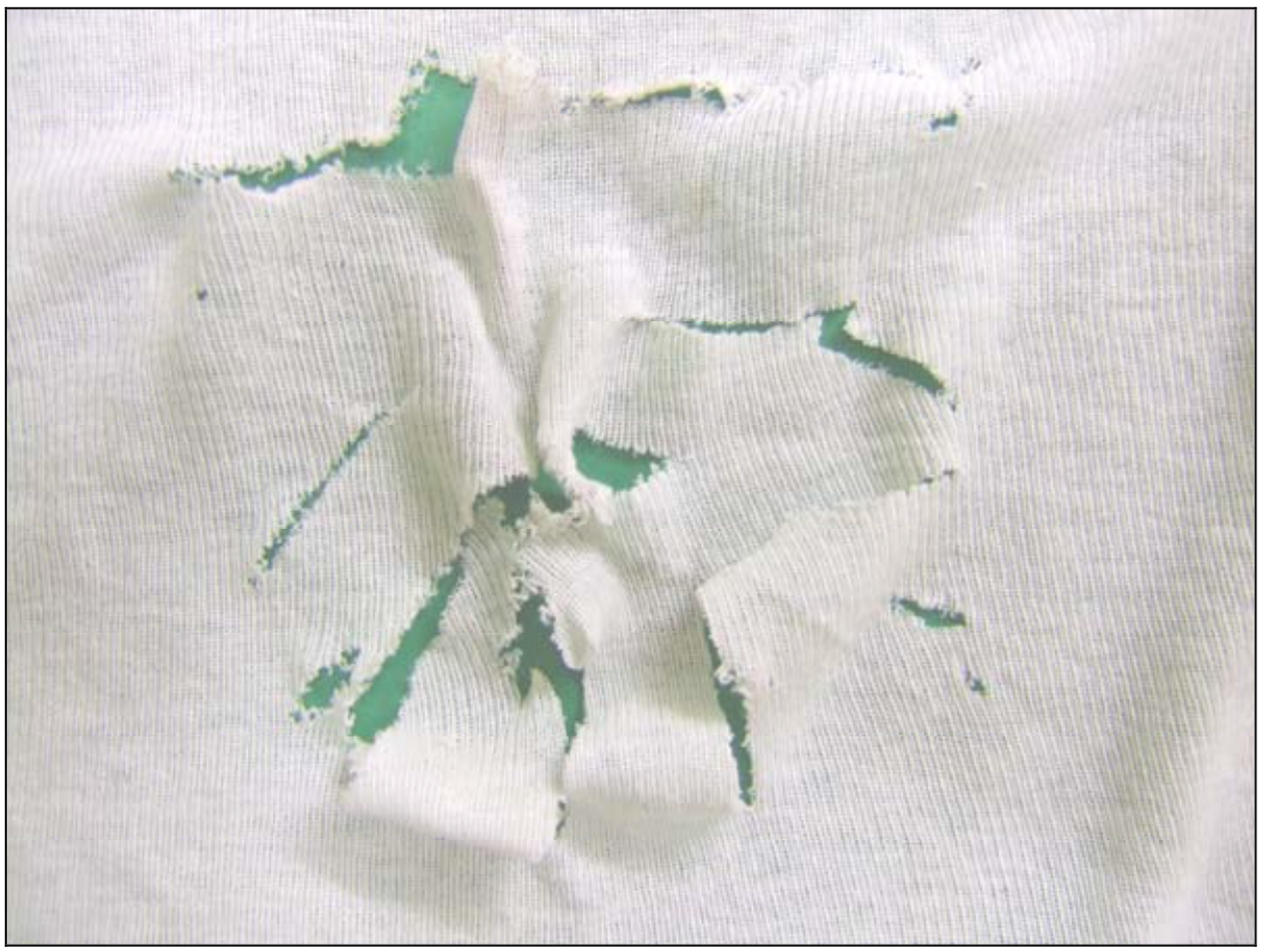Now, let’s look at the single-bevel’s soft-tissue effects. Many seem to place an inordinate amount of importance on size of ‘exit hole in the skin’, with a firm belief that it means more blood ‘on the ground. Thanks to the assistance of Ray Hammond, and Suburban Whitetail Management of North Georgia Inc., it appears there will, in a couple more years, be enough blood trail data, uniformly graded under strict protocols, to offer definitive answers as to whether the size of the ‘hole in the skin’ really makes any significant difference in the degree of blood-trail observed. If there is any ‘average difference’, I’ll conjecture that it will be very, very small indeed.
All data accumulated so far indicates that the degree of blood trail depends only on:
1) Location of the entrance wound.
2) Presence or absence of an exit wound.
3) The location of any exit wound.
4) What organs the arrow hit in between.
So far the frequency of occurrence of the various degrees of blood trail appears pretty evenly distributed among all broadhead types; for ‘like hits’ under ‘similar conditions’ (terrain, ground cover and weather).
Among early data it appears that one of the biggest factors in the degree of blood reported is the level of tracking/trailing experience of those involved. The more experienced the hunter/tracker the higher their ‘average observed’ blood trail rating seems to be. ‘Experience’ is based on the number of animals successfully bow-killed or, in the case of professional guides and trackers, their experience at spooring hit animals. Is there a clue here as to why the degree of blood-trail observed varies so much in the anecdotal stories one often hears? Time will tell. The blood-trail reporting protocols consider not only quantity of blood seen, but the consistency, characteristics and length of the blood trail, as well as shot placement, equipment used, exit wounds and placement, terrain type, ground cover, weather conditions, follow-up technique used and the experience level of both the hunter and the most experienced person involved in the recovery.
All the above notwithstanding, it’s worth noting that the rotation a single-bevel induces also has an effect on the size of the ‘hole in the skin’. Remember how it was mentioned that pliable mediums tend to be compressed or ‘pushed aside’ by the bevel-induced rotation? It’s not uncommon for skin to show this tendency too, especially on arrow-exit. Single-bevel broadheads commonly cause a much larger exit wound through the skin than does a comparable-width double beveled broadhead. Indeed, it’s frequently wider than that left by the wide cut double-bevel broadheads. As the broadhead exits the skin, its twisting motion commonly results in an L-shaped exit wound, with a total cut-width far exceeding the broadhead’s width.

Photo 17 shows the flesh side of an exit wound on one of the trophy-size buffalo bulls, from the 2007 testing. This exit-wound was made by a 1″ wide Modified Grizzly on an Internally Footed Extreme FOC arrow. As a size-gauge, the hide shown has a thickness of approximately 1″. It wasn’t until testing the fully penetration-maximized Internally Footed Extreme FOC arrows that this feature showed up in the buffalo testing. Prior to that there weren’t any significant exit wounds to look at! This hole measures 2″ wide, “as the crow flies”. Around the bend, it’s even bigger!
The L-shaped exit isn’t at all uncommon with thin-skinned animals, but rarely are they quite as dramatic as the one shown above. I’d conjecture that the very fact that a buffalo’s skin is so thick, tough and highly fibrous was a big factor. It’s likely that there was significant ‘spiraling’ of the skin around the broadhead as it rotated while penetrating the hide, and before the skin was completely sliced through. Remember, just like with bone, the Modified Grizzly would have been trying to rotate through a large arc during the time its 3-1/8″ long blade was passing through the off-side skin!
Unlike entrance-side skin, there’s little to prevent the off-side skin being stretched away from the underlying tissue as the broadhead passed through. If you’ve ever seen any of Dr. Frank Chamberlin’s high-speed photos, taken at Aberdeen Proving Grounds, of a bullet exiting off-side skin of goats, pigs and mules, you’ll know exactly what I mean. It was common for the skin to distend nearly a foot away from the underlying tissues before the bullet exited. Even with a cut-on-impact broadhead, skin gets ‘pushed up’ a lot before the pressure is sufficient to cut through. Just try pushing your broadhead through a piece of moderately-taut fresh hide and see how far it stretches out before it’s pierced!
Does this tendency to ‘push’ and ‘twist’ pliable tissues mean a single-beveled broadhead pushes meat, blood vessels and lung tissue aside, rather than slicing them? Not at all. Try winding some spaghetti around a sharp knife blade. After it’s ‘wound up’, what happens if you push the knife’s blade forward while also rotating it, so as to keep the spaghetti strands ‘wound up’? The spaghetti gets cut; and far more of it ends up being cut than if you simply ball that spaghetti up equally tight and push the sharp knife straight through! Dissections of single-bevel broadhead wounds channels show some of the same effect.
One easy way to see this difference is to try your broadheads against a piece of loose cloth. First, try the double-bevel. Remember it won’t be rotating, so just push it through. Next, try the single-bevel. ‘Wind it up’ a bit by twisting the cloth around the broadhead, by twisting the arrow clockwise (for a right-hand bevel). Just a quarter-turn (90 degrees) of the broadhead will do. Now, push the broadhead through, remembering to continue to rotate the single-beveled head in the appropriate direction as you push it through. That’s what it will actually be doing; continuing to rotate and ‘winding up’ the pliable tissue until it cuts through. Take a look at the cut shape and the difference in total cut-area between the two cuts.

Photo 18 shows the resulting cut through a shop rag when the cloth is ‘wound-up’ 1/4 turn, and arrow rotation continued while the broadhead is pushed through. Do you see the similarity with the buffalo hide exit wound shown above in Photo 17? The total width of the L-shaped cut made by this 1″ wide single-bevel broadhead measures 2.25″ – almost identical to that shown in the buffalo’s hide.

Photo 19 shows what happens if the rag is wound up a half turn before pushing the same broadhead through, while continuing arrow rotation. You won’t see this ‘star-burst’ pattern often in soft tissues, but it is often observed in intestinal tissues. It shows up there because, though supported by mesenteric tissue, intestines are far more mobile than other tissues, and are also very fibrous; it’s simply easier to get them ‘wound up’. This may be one reason I’ve never failed to recover a gut-hit animal when using a well-sharpened single-bevel broadhead; though I prefer to think it’s how I manage the follow-up after the hit.
Besides bone breaks, among the single-bevel wound features that you will routinely see are:
1) Wound channel cuts that are considerably wider than the broadhead’s cut-diameter.
2) L- shaped cuts, which commonly appear on internal organs, especially heart, liver, renal and intestinal tissues.
3) ‘Mushing’ and bruising of lung tissue.
None of these are exhibited with single-bevel broadheads. A block of ballistic gel can be used to show the ‘mushing’ effect of a single-bevel broadhead, but you’ll need to actually shoot the arrow through it rather then pushing it thorough slowly. Also note that temperature of the ballistic gel is a variable factor, affecting its ’tissue simulation’ capability; from soft lung tissue to very firm muscle.
If you don’t have ballistic gel available, a big block of nice, firm Jello works pretty well too. Yet another suitable target for showing this ‘mushing’ effect is a ripe watermelon. Whether using ballistic gel, Jello or watermelon, you’ll need to do this demonstration on a bare shaft, and at relatively close range; for broadhead/bare-shaft accuracy reasons. If you don’t use a bare shaft, the damage the fletching does in these very soft materials can distort the results.
The ‘mushing’ and bruising seen in lung tissues is why you’ll sometimes hear Ray Hammond refer to how the single- beveled El Grande he uses has “scrambled the lungs” on one of those huge Georgia pigs he’s so fond of skewering!
You can learn a lot about how different broadheads perform by carefully observing the type and degree of tissue damage they cause; something most bowhunters fail to take advantage of.
To see the difference a single-bevel makes, you can try these simple tests yourself. Or, better yet, just shoot a few animals and take a close look at the entire wound channel to see what’s happened. On wound dissections, a single-beveled broadhead exhibits a clearly noticeable increase in tissue damage over a double-beveled head.
There are also other, more subtle advantages to having a single-bevel on your broadhead. It’s easier to get a thinner (ergo, sharper) edge with single-bevels. The 25 degree bevel I use represents the total edge-bevel angle; because the other side has a zero-degree bevel. To get an equally thin double-beveled edge you’d have to sharpen each side at 12 1/2 degrees.
The Pro Big Game has such an angle – and it’s very hard to work with, since all sharpening has to be done lengthwise to the blade; you can’t get anywhere near that ‘flat’ an angle working across the ferrule.
Because of the much thinner edge (at any given sharpening angle), single-bevel broadheads do need to have harder steel to prevent the edges rolling. I once thought R49 represented the minimum hardness needed for a good single-bevel, but subsequent testing indicates that R52 to R55 represents about the minimum hardness for peak performance and edge durability. Yes, higher broadhead hardness means more work sharpening them, but it also means they hold their edge better; they start out sharper and remain sharper throughout penetration. And, no, at these hardness levels it doesn’t result in a brittle blade. All the 190 Grizzlies I’ve ever had tested (and that’s a bunch) have shown between R52 and R55, and I’ve never damaged a single one on any tissue; either when hunting or during testing. They are definitely hard enough to hold their edge and not so brittle they’re prone to breakage – at their thickness.
What other advantages does a single bevel give you? Because of its thinner edge, even at equal sharpness it will slice deeper than a double-bevel; at any given level of tissue-tension against the blade’s edge. Why? The bevel’s long slope means the edge has a higher mechanical advantage. This means it can do more ‘work’ with whatever force is applied to it; ergo, it slices equally well with less force than an equally-sharp double-bevel, or better at the same level of force.
Single-bevels also make thinner and cleaner cuts. That’s one reason why both wood planes and carpenter’s hatchets have single bevels; they easily cut-away beautiful thin curls, and with less force than you’d have to use with a double-bevel.
Tissue tension against a cutting edge is one of the many factors that affect the degree of cut achieved. All broadheads enhance the tension of soft tissues against the blade’s cutting edge; the wedge-effect of the blade and ferrule contour assures that. These features force the tissue apart, tensioning the tissue and making it easier to cut; exactly like the difference between trying to slice through a loose rubber band and one that’s taut. But a rotating broadhead not only has these tensioning features, it also increases tissue tension by virtue of the spreading effect the rotating blade-face exerts on them. More tissue tension, regardless of how it’s created, equals a better and more efficient cutting action.
And, not to be overlooked, a thin rotating edge results in slicing more of the blood vessels at an angle. This means many of the severed blood vessels will be cut on a bias, opening a larger surface area of the vessel and making it harder for
Coagulation (clotting) to stem the blood flow. Yes, blood vessels run at all sorts of angles, and a non-rotating double-beveled blade also cuts many on a bias; but not nearly so many as the rotating single-bevel does.
If you doubt that broadhead rotation results in more ‘bias-angle cuts’, go back and try both edge types on a big ‘glob’ of spaghetti; remembering to rotate the single-bevel; and then look closely at the severed ends of each strand and count them! It’s purely a mathematical probability thing. Having multi-dimensional ‘random variables’ results in an increased probability the cut won’t be perpendicular. The spaghetti’s (or blood vessel’s) position is relatively static, but the single- bevel blade is both moving forward and simultaneously subtending an arc of rotation while the cut is being made.
The end result of the increased ‘chance encounters’ between the static blood vessels and rotating cutting-edge is more vessels being cut on the bias; with freer-flowing hemorrhage (bleeding) from more of the vessels severed, and cuts that are less likely to be sealed-off by coagulation (clotting). The smaller the blood vessel involved, the greater the likelihood you’ve created a cut that will continue to bleed freely.
Not to leave the wrong impression, you won’t be able to see every commonly occurring single-bevel effect on every shot into every animal. However, after you’ve examined a few, you’ll find these features present. Most pronounced, and most easily seen, is the difference in splitting the long-bones; and the resulting greater outcome penetration.
When using a single-beveled broadhead, remember to always make the arrow’s rotation in flight match the bevel-induced rotation. This means right wing fletching with a right single-bevel, like the Grizzly; and left wing with the left bevels, such as the Abowyer. If you fail to do this, a double-beveled ‘like-broadhead’ will out-penetrate the single bevel. Why? Because, by mixing arrow rotation in flight and what the bevel induces after the arrow impacts, you’ve set up a situation where the arrow not only has to stop it’s rotation on impact, it has to change the direction of rotation and accelerate the rotational rate in the new direction. That uses up a lot of the arrow’s energy, directly reducing arrow force (momentum) available for penetration.
Hopefully, this information will lift some of the shroud of mystery surrounding how and why single-bevel broadheads work, and why those of us who use them regularly are such strong proponents. The demonstrated lethality benefits of single-bevel edges are both numerous and significant.
About the Author:
Dr. Ed Ashby invested 27 years in the study of arrow performance and broadhead lethality. His testing is the closest thing to the scientific method as is possible under field-testing conditions. Never before has anyone tested arrow and broadheads on actual game animals on such a scale. The test results have been carefully compiled and are now available to the public free of charge at Alaska Bowhunting Supply.
Bowhunters everywhere owe Dr. Ashby a debt of gratitude as his data reveals which broadheads and arrows perform the best on real game animals. The results show that whether you shoot a traditional bow like a recurve or longbow, or a compound, the arrows and broadheads that performed well in testing, will perform for you where it matters most, in the field.
His goal is to educate the world on what kinds of arrows and broadheads best penetrate big game animals. He receives no compensation for any of his research but shares the results freely. He wants to educate bowhunters everywhere on what works best on big game animals so the animals may be harvested in the most efficient manner possible.

